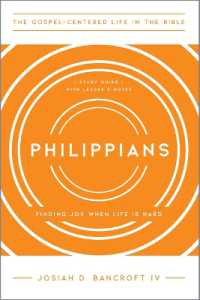Full Description
Children experience a range of emotions during their time in primary school; however, bereavement is both unique and challenging. This book seeks to enable adults working with children to be prepared for this part of life's journey and ready to support the child affected by the death of their loved one.
This accessible book explores topics that may have not been fully explored during teacher training, including defining loss, grief and bereavement, looking at different models of grief, identifying how grief affects children and investigating how the differing needs of minority groups can be met. Focussed on delivering practical and hands-on guidance, readers are presented with expert advice and case studies from the classroom to understand how to create an effective childhood bereavement policy. Whilst supporting a bereaved child is crucial, the emotional toll on the adult should not be underestimated and this book offers applied self-care strategies tailored for educators. A resource bank with contact details for specialist childhood bereavement organisations is also included for quick reference in a crisis. The authors also make suggestions for play-based activities and guided tasks using high-quality texts for school adults to use in small groups or with the whole class.
This is a much-needed resource for every classroom to best support young people experiencing anxiety, depression and mental health issues after facing a death. This book gives primary teachers, school leaders and staff the confidence to build learning environments that nurture and support students through this difficult time.
Contents
1. Introduction 2. Loss, grief and bereavement 3. The way we experience death of a loved one 4. Stages of grief 5. How children understand death 6. Different views of death and the afterlife 7. Childhood Bereavement Policy 8. What can we learn from special schools? 9. What can we learn from a hospice? 10. Supporting minority groups 11. Lived experiences of grief and bereavement 12. How to support and look after yourself 13. Resource bank 14. Conclusion








